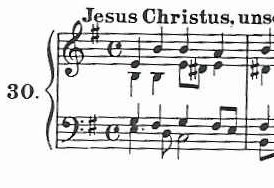In the Music of Bach (Part Two): The Spanish Cadence |
| The Spanish Cadence in Bach’s Musical Structures: Harmonic Aspect of the Chaconne The simplest form of the cadence traditionally called a Phrygian cadence consists of a first inversion subdominant chord (or a root position submediant chord) proceeding to a dominant chord in root position in the minor mode. I call this a Spanish Cadence, by way of compromise. Moorish Cadence would be more precise. (You have my permission to object to this terminology if you know where Phrygia is.) To this day, this harmonic progression is characteristic of Spanish music. The famous Malaguena by the Cuban composer Ernesto Lecuona consists entirely of this progression, enthusiastically reiterated. The complete form of the Spanish Cadence, for purposes of this discussion, rides on the bass progression from the tonic tone downward to the submediant and concluding on the dominant. This is the harmonic aspect of the chaconne. The first chord is usually the tonic, but the first inversion of the submediant is a frequent substitute. When the bass moves stepwise downward, the sub-tonic note usually accompanies a first inversion minor dominant chord. This is then followed by the first inversion subdominant on the submediant note, and then the regular dominant (major triad) in root position. An excellent (if slightly embellished) example of this progression is in the first five quarters of Bach's harmonization of the chorale Jesus Christus, unser Heiland (Bach-Riemenschneider #30) (Example 135.1). |
 |
| Example 135.1 |
 |
| MODULES The Chaconne In the Music of Bach (Part Two): The Spanish Cadence Lester Allyson Knibbs, Ph.D. |
Introduction The Chaconne --- Cadential Structure Unitary & Binary Structures Linear & Periodic Structures Modules and Modalities Structural Counterpoint Modular Composition Appendices |
| Origins Toward Cadential Structure In the Music of Bach: Back In Cadential Structure After Bach In Symphonic Composition In Twentieth Century Music |
| In what I am calling the Spanish Mode, what would in the minor mode be considered the dominant chord (the E major triad in the key of A minor, for example) is in the Spanish Mode the tonal center, and the Spanish Cadence (or some variant) into that chord concludes the piece. A number of Bach's chorale harmonizations are in this Spanish Mode (or, at least, conclude in it). More often than not, the descending melodic motion to the final tone is not in the bass, but in the soprano voice. Bach-Riemenschneider chorale harmonizations ##3****, 10, 16***, 21*, 34, 56 (elaborate), [74]*, [80]*, 81**, 89*, [98]*, 113**, 132, 181 (descent is in bass; sounds more like a half-cadence in E minor), 190, 198**, 205 (elaborate; descent is in tenor), 208 (conclusion resembles conclusion of a classical Spanish song set by Obradors, but still sounds like half-cadence in E minor to me; descent is in bass), 214, 253****, [262]****, 270*, 286*, 307**, [333]***, 345*, 352*** and 367*. (All those marked with asterisks are harmonizations of chorale melodies identical or similar to those with the same number of asterisks. Those enclosed in brackets are not harmonized in the Spanish Mode and are listed here only for the purpose of comparison.) |